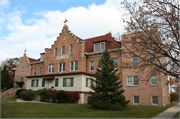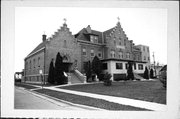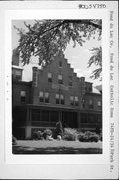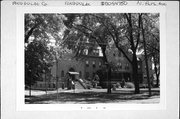Property Record
271 N PARK AVE
Architecture and History Inventory
| Historic Name: | The Henry Boyle Catholic Home for the Aged |
|---|---|
| Other Name: | Boyle Apostolic Center |
| Contributing: | |
| Reference Number: | 54750 |
| Location (Address): | 271 N PARK AVE |
|---|---|
| County: | Fond du Lac |
| City: | Fond du Lac |
| Township/Village: | |
| Unincorporated Community: | |
| Town: | |
| Range: | |
| Direction: | |
| Section: | |
| Quarter Section: | |
| Quarter/Quarter Section: |
| Year Built: | 1902 |
|---|---|
| Additions: | 1930 1958 |
| Survey Date: | 2010 |
| Historic Use: | live-in care facility/sanitarium |
| Architectural Style: | Late Gothic Revival |
| Structural System: | Unknown |
| Wall Material: | Brick |
| Architect: | Adolph Werner |
| Other Buildings On Site: | |
| Demolished?: | No |
| Demolished Date: |
| National/State Register Listing Name: | Not listed |
|---|---|
| National Register Listing Date: | |
| State Register Listing Date: |
| Additional Information: | Photo code #2: 74FD-24/33,34. 1988:This three-story rambling building is constructed of brick. It has a steeply pitched hip and gable roof with stepped parapet gables. The north parapet gable section appears to have been built later than the main block. The gable of the main block is also decorated with small oriels. The roof eaves of the main block are decorated with modillions and shed roofed dormers project from the roof. A porch of round columns and a spool and spindle balustrade has been enclosed with modern materials in recent years. 2010-2011 Intensive Survey Report Info: Faced with brick, this religious institutional facility is comprised of three periods of construction that range from 1902 to 1958. Rising from a limestone foundation, the original (1902), central portion of the structure is topped with a hipped roof with smaller shed-roof dormers but is dominated by a gabled dormer fronted by a Bedford stone-trimmed, stepped parapet and accented by a single, small castellated turret at either side. A one-story porch (which was enclosed between 1974 and 1988) extends across the front of the building and includes modern fenestration. Remaining windows throughout the structure are arranged singly and in pairs and consist of one-over-one-light sashes. Between the second and third floors a rectangular stone inset is inscribed with the words: "THE HENRY BOYLE CATHOLIC HOME FOR THE AGED." Located to the south of the original block is a brick-faced, gabled chapel that was added in 1930. Like the 1902 block, the chapel's primary elevation features a stepped parapet with stone trim. A central, Gothic-arched opening carries a pair of wooden doors as well as a stained-glass transom. Gothic-arched windows are located to either side of the entry, as well as along the building's north elevation, which also features modest corbelled brickwork. Finally, a three-story, brick-faced wing was added to the 1902 building in 1958. This addition includes both paired and single, double-hung sash windows and is topped with a flat roof. A 1904 photo of the original block indicates that aside from the porch enclosure, the building appears much as it did when constructed. The subject building, known as The Henry Boyle Catholic Home for the Aged, was built through the philanthropic efforts of Fond du Lac businessman Henry Boyle. Boyle was born in Waterloo, New York, the son of Irish immigrants. Henry and his brother John, along with their mother and sister came to Fond du Lac in 1873. The Boyle brothers would eventually develop the #28;Yeast Foam#29; brand which was made by their firm named the Northwestern Yeast Company. Their business was financially successful and soon they served as directors of various boards and began their philanthropic efforts. Henry was the financier and namesake of the subject structure which was completed in 1902 and cost approximately $20,000. The architect of the original building was Adolph Werner and its general contractor is noted as Thomas O'Connor and the mason work was handled by Hutter Construction. A 1902 description of the building indicates it included only approximately twenty-seven sleeping rooms, rather than the forty anticipated at the outset. A kitchen and dining room was originally located on the first floor, along with private dining and pantry facilities for the Sisters of St. Agnes, who were in charge of running the institution. A variety of sitting rooms were located on the first and second floors, while bathrooms were located throughout. The home was intended "to be a refuge for penniless and helpless aged persons. One of the requirements is that they must be bona fide residents of Fond du Lac not mendicants sent here from other cities...". Following construction, the property was deeded to the Sisters of St. Agnes. Henry Boyle died in 1918 and his widow Julia is said to have financed the construction of St. Patrick's Chapel, which was estimated to cost $20,000. Again, an architect is not noted, however, contractor Stephen Andrew is cited on the building permit. In 1958, the three-story addition was constructed at the building's south end. The facility continued under the care of the Sisters of St. Agnes until building a new facility closer to St. Agnes Hospital. The building is currently for sale and its advertisement indicates that it includes thirty rooms, a chapel, as well as a pastor's apartment. |
|---|---|
| Bibliographic References: | A. City Directories for the City of Fond du Lac, on file at the Fond du Lac Public Library, Fond du Lac, Wisconsin. B. Sanborn Perris Maps for the City of Fond du Lac, on file in the Archives of the State Historical Society of Wisconsin, Madison, Wisconsin. C. Tax Rolls for the City of Fond du Lac, on file in the Area Research Center of the Unviersity of Wisconsin-Oshkosh Library, Oshkosh, Wisconsin. D. Carol Cartwright, City of Fond du Lac Intensive Survey Report, Fond du Lac: City of Fond du Lac, 1992. |
| Wisconsin Architecture and History Inventory, State Historic Preservation Office, Wisconsin Historical Society, Madison, Wisconsin |





